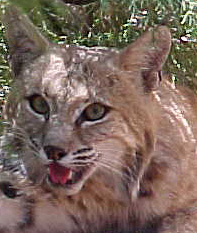
Captured
Bobcat
Tucson, Arizona
|
Bobcats (continued from Page 1)
Bobcats
may be incidental carriers of the rabies virus, usually in
the
summer months, and have been known to attack people with impressive
ferocity. This usually results in substantial wounds as well
as
the need for immediate inoculation against the disease.
Bobcat
territories may be as large as 25 square miles for males and 4-10
square miles for females. They make routine circuits of these
areas, often taking a week or two to completely cover the
area.
Stealth
and patience are the two main hunting skills possessed by these wild
cats. They are crepuscular, being most active a few
hours
before and after sunrise and sunset. Because they are in that
precarious position in the food chain where they are not only predators
but also sometimes prey to other species such as mountain
lions
and coyotes, bobcats prefer brushy, rocky habitat with escape
routes. Urban and suburban habitats are acceptable because no
hunting or trapping is allowed, dogs must be on leashes, and
wild
predator populations are minimal.
Like
all felines,
bobcats are inactive during much of the day. Hunting beds are
often used, where a ‘cat has a good field of vision to spot
prey
or potential danger, yet feels comfortable enough to actually rest or
sleep while waiting until hunger once again spurs it into
action. The term “cat nap” comes from such behavior.
Click here to continue reading on
Page 3 |